How To Install Dry Stack Stone Veneer
Rock Veneer Installation
The following guideline is a general overview of the proper steps involved when installing natural or manufactured thin stone veneer, in the traditional method, where no special circumstances are present. Your specific project may exist unique and may require additional steps. Please contact an RCP Block & Brick to discuss your particular projection. View all bachelor Stone Veneer styles.
Things to Keep In Heed
- Proceed your hands and your stone veneer clean during the installation process
- It is important not to let mortar to dry on the face up of the stone. Moisture mortar on rock will go out a filmy residue that dulls the appearance of the rock and should be removed immediately before it dries/hardens. Removal can be accomplished using a stiff brush and make clean water
- Place a protective cloth on the ground where rain or water tin can crusade mud to splash onto your stone
- All rock should be practical co-ordinate to local building codes
- Water infiltration and harm tin be caused from incorrect installation. Stone should be installed at least 3" in a higher place grade level to forestall h2o from continually saturating behind the back of the rock and causing structural damage
Pace 1: Calculating Materials
Before y'all can begin the installation projection, yous will need to calculate the proper amount of material for your thin rock veneer projection.
How Much Stone Do Yous Need?
Begin past figuring the square footage of the area y'all plan to encompass with rock (length x height). If your projection includes corner stones, deduct 1 foursquare foot for each linear foot of corners that you will utilize. Not Certain? Call RCP Cake & Brick and we tin aid calculate your rock needs.
Consider Mortar Joint Size:
One aspect to consider when calculating your materials is the size of the mortar joint between the pieces of stone. Most rock is packaged assuming a 1/2" mortar joint. If your joint volition vary (such equally a dry-stack or over grout awarding) adapt your estimates accordingly.
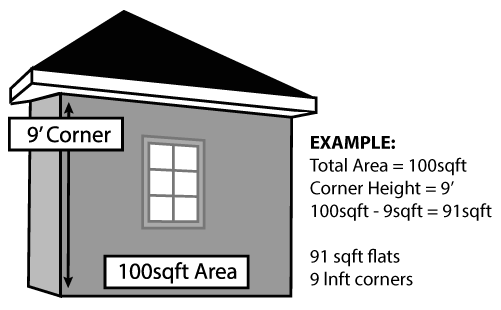
Computing Rock Veneer Quantity
Stride 2: Surface Preparation
Preparation of the surface is a key attribute in preventing any water impairment and making sure your stone veneer project remains structurally sound for the life of the installation.
Framed Exterior Wall:
Including Plywood Paneling, Wall Capsule, or Flush Metal Siding
Cover surface with a weather resistant barrier such every bit tar paper. Be sure to overlap joints four" in shingle mode. In accord with local building codes, install metal lath on meridian of the weather resistant barrier using galvanized nails or screws 6" on center vertically and 16" on center horizontally, penetrating the studs a minimum of 1". Finish the metal lath 1" from finished edges. Be sure to wrap all corners overlapping the metal lath at lease 4".
Framed Interior Wall:
Including Plywood, Sheetrock, Green Sheetrock, or Fiber Cement Board
In In accordance with local building codes, install metallic lath using galvanized nails or screws 6" on center vertically and 16" on heart horizontally, penetrating the studs a minimum of 1". End the metallic lath 1" from finished edges. Be sure to wrap all corners overlapping the metal lath at lease 4". (It is not necessary to utilize expanded metal lath on cobweb cement board unless required by local building codes)
Concrete Exterior or Interior Wall
Including Cleaned and Untreated Physical, Masonry, or Stucco
Stone veneer can exist installed directly to these surfaces if make clean and absent of whatever paint or droppings. Be certain to inspect new concrete to insure there is no release agents (form oil) on the surface. If release agents are nowadays, compose the surface of the concrete with etching agent. Surfaces that take been painted must be sand blasted or otherwise stripped of pigment. Surface must be free of pigment, dust, or dirt. If cleaning of surface is as well difficult, metal lath may be affixed to the surface with concrete nails. In accordance with local building codes, install metal lath using galvanized nails or screws 6" on heart vertically and 16" on middle horizontally, penetrating the studs a minimum of one". Stop metal lath 1" from finished edges. Be sure to wrap all corners, overlapping the metallic lath at least 4"
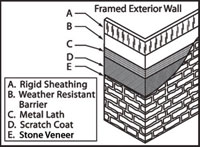
Framed Exterior Wall
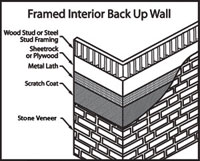
Framed Interior Wall
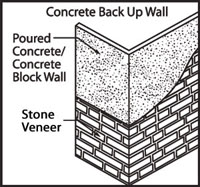
Concrete Interior or Exterior Wall
Step 3: Scratch Coat
A scratch coat will exist needed when metal lath is used. This step is not necessary when applying stone veneer to a cleaned physical, masonry, or stucco surface.
Mixing the Scratch Glaze:
1 part Type Southward Masonry Cement to 2.5 parts sand. Dry out mix the sand and cement together and avoid creating clumps in the mixture. Add together water slowly to the mixture a footling at a time, continually mixing until you have achieved the consistency of a paste or whipped potatoes. Mix a minimum of 5 minutes.
Applying the Scratch Coat:
If a scratch coat is necessary, utilise a masonry trowel to utilise a 1/ii" to 3/iv" layer of the scratch coat mix over your metal board. Encompass the entire area of the lath, working the cement into the holes and scraping off any excess. Use a notched trowel to lightly rake horizontal grooves in the scratch coat while the cement is all the same slightly wet and allow to dry for 24 hours.
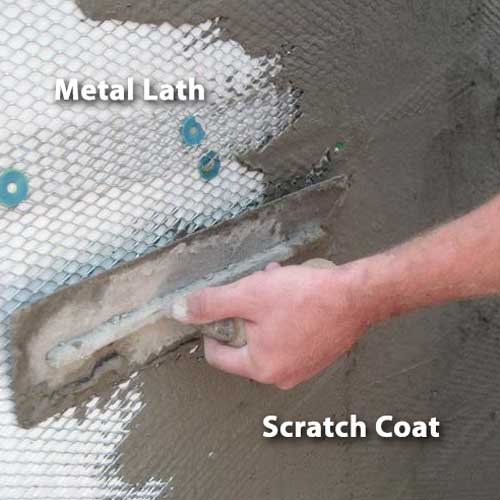
Applying Scratch Glaze to Metal Lathe
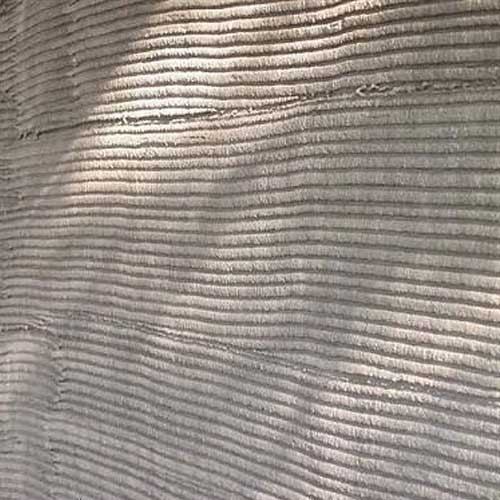
Grooves Will Aid Mortar Bail
Step 4: Preparing Your Rock for Installation
To achieve the best results, at that place are a few things you should take care of before starting your stone veneer installation.
Plan Your Layout:
Before applying the stone, it is a adept idea to lay the stone out apartment to determine the sizing and colors of each individual piece, how they will be laid out for your projection, and if any trimming is necessary. Attempt to continue joints a consistent height and width. Commonly vertical and horizontal joints should be staggered to prevent long, unbroken lines that may draw the heart to a particular area.
Trimming the Stone:
If cutting the stone is necessary, a Skill saw with either a dry out or wet cut diamond or masonry bract will piece of work. You may too desire to use a masonry hammer to break the stone, giving it a more natural appearance. A nipper tin can also be used to trim minor amounts off the rock.
Clean the Rock:
Be sure that the surface of the stone is free of dust, dirt, or any loose particles. If necessary, launder the stone completely and allow to dry.
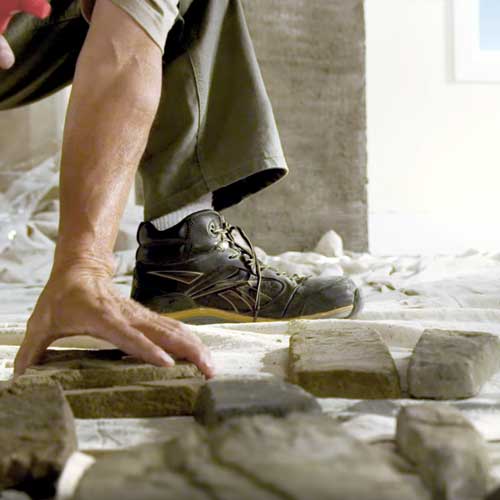
Plan Your Layout Before Installing
Footstep five: Installing the Stone Veneer
You volition be affixing the stone veneer to the scratch coat using a stone veneer mortar. Below are the steps involved.
Mixing the Mortar:
Employ a pre-blended, polymer fortified Type S mortar and water known every bit SVM (Rock Veneer Mortar). Call an RCP Cake & Brick nearly you lot for bachelor products and tips. Mix according to manufacturer's directions.
Installing the Stone:
It is recommended to install all corner pieces first before installing the field. Information technology is also recommended to work your way from the bottom to top.
Utilise a masonry castor or sponge to dampen the dorsum of the rock, but do not saturate it. This prevents the stone from pulling moisture abroad from the mortar allowing information technology to dry out naturally and with a stronger bond.
To lay the stone, use a masonry trowel to butter the dorsum of the stone with i/two" to 1" layer of mortar. Using your trowel, create a ridge around the outside back of the rock. This will create suction when putting the rock in place, which will help to hold the stone until the mortar sets up. Lay the rock confronting the wall, pressing and rotating slightly, forcing some of the mortar to clasp out freely.
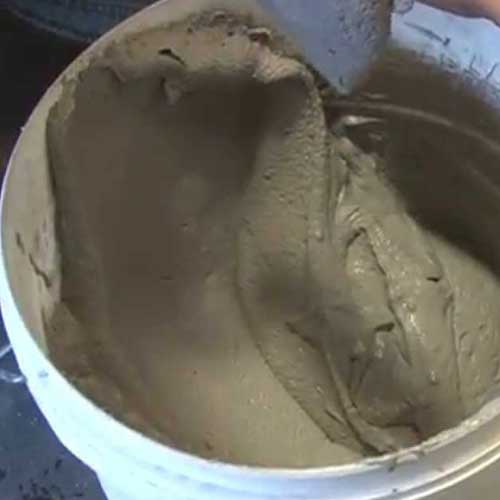
Mixing Stone Veneer Mortar (SVM)
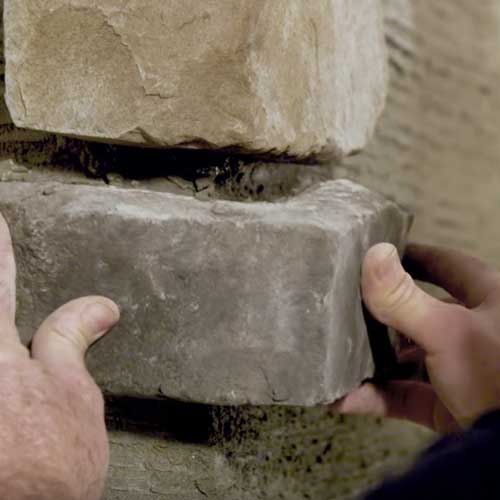
Installing the Stone Veneer
Step six: Grouting and Tooling
Once the stone has been affixed to the scratch coat using mortar, the joints, or gaps between the stone, volition be filled with grout.
Filling the Joints:
Use Pre-blended Type Southward mortar. Using a grout purse, cut a hole approximately one/2" in the tip of the handbag (if pigsty is not already provided). Fill your grout handbag about one-half total with your grout mixture. Twist the top cease of the bag and squirt a small corporeality into a saucepan to prevent air pockets. Make full all the joints betwixt the stones with about a 1/ii" layer of mortar (more than or less depending on the desired outcome and joint size.)
Tooling the Joints:
As the grout stiffens, tool to the desired depth using a joint tool. Brush the joints with a whisk broom to smooth them out and make clean away any loose mortar. Grout is ready for finishing when it crumbles abroad similar sand when brushed. If the grout smears or falls away in large chunks, it is still too wet for brushing or striking. Finally use a soft bristled brush to sweep the dust off the stone.
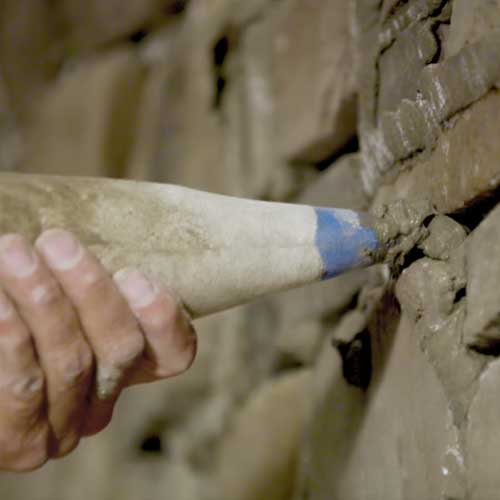
Grout Between Stone Pieces
Source: https://www.rcpblock.com/installation-stone-veneer.html
Posted by: brownpospits1945.blogspot.com


0 Response to "How To Install Dry Stack Stone Veneer"
Post a Comment